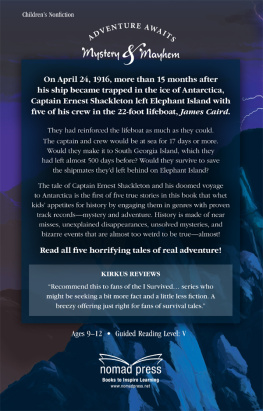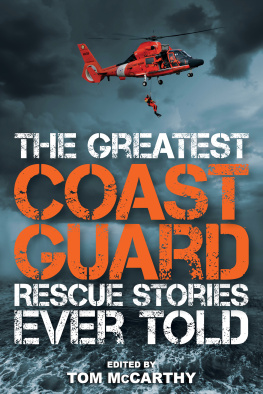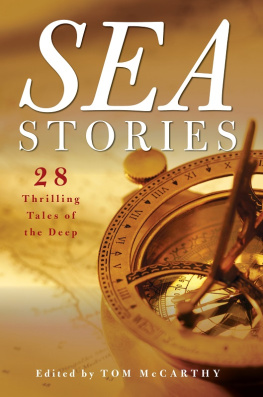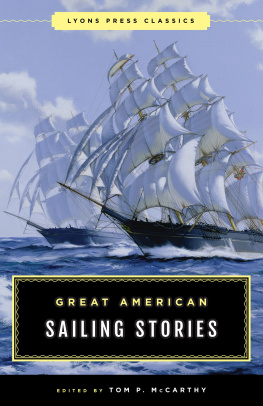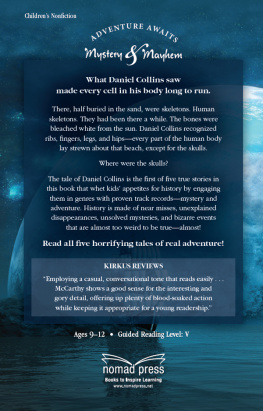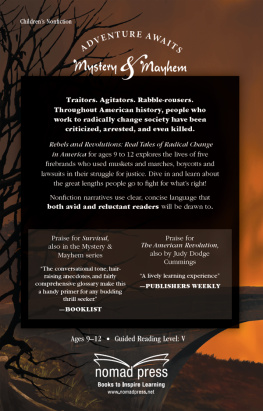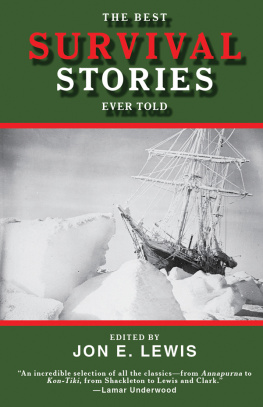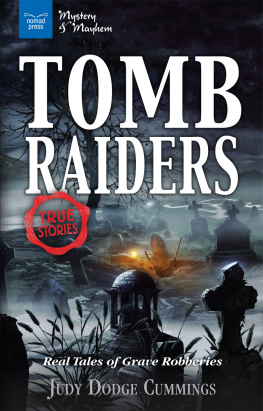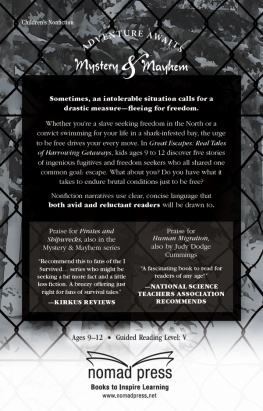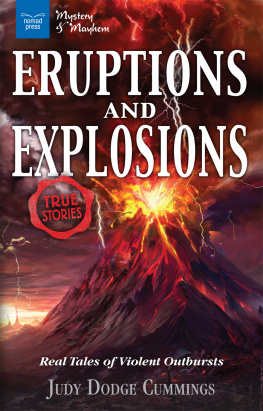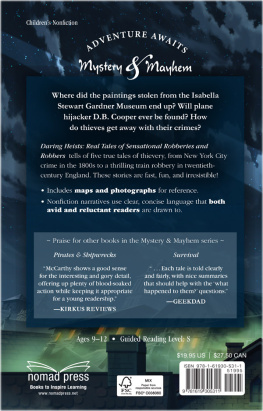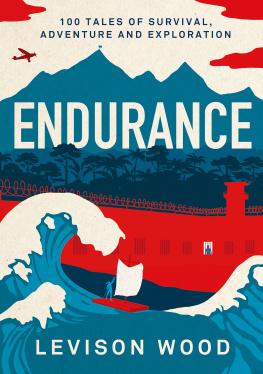

Current titles in the Mystery & Mayhem Series

Check out more titles at www.nomadpress.net
Nomad Press
A division of Nomad Communications
10 9 8 7 6 5 4 3 2 1
Copyright 2016 by Nomad Press. All rights reserved.
No part of this book may be reproduced in any form without permission in writing from the publisher, except by a reviewer who may quote brief passages in a review or for limited educational use. The trademark Nomad Press and the Nomad Press logo are trademarks of Nomad Communications, Inc.
Educational Consultant, Marla Conn
Questions regarding the ordering of this book should be addressed to
Nomad Press
2456 Christian St.
White River Junction, VT 05001
www.nomadpress.net
Contents
The most interesting thing about survival stories is that they make you wonder if you could do the same thing. Would you have the smarts, the strength, and the coolness to get out of a tough situation? Could you handle watching your frozen fingers break off in Antarctica or seeing mirages of wonderful cooling lakes while youre dying of thirst in Death Valley, California?
In this book, you wont find boring stories that leave you thinking, So what? My grandmother could have done that.
Take the tale of Captain Ernest Shackleton, for example. He took his crew on an expedition to the frozen Antarctic in an attempt to cross the entire continent, something no one had done before. But a simple, dumb mistake doomed the plan. Captain Shackleton had to do more than just figure out how to keep everyone alive. He had to make it back home across cracking and shifting ice and raging oceans with roaring winds and towering waves.
Maybe you would have liked to sail with William Bligh, who annoyed his crew so much they threw him and his loyal followers into a small boat in the middle of the vast Pacific Ocean. The men were set adrift thousands of miles from anywhere.
What about trekking with William Lewis Manly on his trip across Death Valley? This is the lowest, driest, hottest place in the United States. Its a long walk, with very little water to be found.
Speaking of deserts, join Mademoiselle Picard on her journey through the desert on the coast of western Africa. After surviving a tragic shipwreck, she and her family faced a long walk to safety filled with perils.
On the other side of the world, Eliza Donner and her family, along with several other families, encountered a different kind of extreme landscape. They found themselves trapped in the snow high in the mountains on their way to a better life in California, fighting for their survival. People today are still wondering how the survivors managed to do just thatsurvive.
So what do you think? Do you have what it takes to overcome the severest obstacles and make it home safely? Would you survive?

Men wanted for hazardous journey. Low Wages, bitter cold, long hours of complete darkness. Safe return doubtful. Honour and recognition in event of success.
An advertisement said to have been placed in 1914 by Captain Ernest Shackleton for men to accompany him to Antarctica
The most important question is, why? Why, under any circumstance, in any condition, would someone want to go anywhere with Captain Ernest Shackleton?
The man was quite possibly crazy. He had shown that by putting himself and his crews in the most extreme discomfort for months at a time long before he paid for his latest advertisements in English newspapers in 1914.
At the time that Captain Shackleton might have placed the advertisement, only 10 men had ever stood on the South Pole. Five of those 10 men died soon after, trying to get safely home.
So why?
By 1914, what newspapers around the world had been calling The Race to the Pole was over. For years, this race had captured the worlds attention as different teams made heroic attempts to be the first to travel to the South Pole, only to fall short of the goal.
Captain Shackleton had been in the race. He had tried to reach the South Pole twice, once in 1901 and again in 1908.
But he hadnt made it.
Captain Shackletons friend, an explorer named Robert Falcon Scott, also tried to be the first to the South Pole. His expedition was beaten in 1911 by a Norwegian explorer named Roald Amundsen. Robert Falcon Scott and his own team of explorers had been right behind Roald Amundsen. They reached the South Pole five weeks later and were devastated to see that Norwegian flag whipping in the wind. They had lost.
One member of Robert Falcon Scotts team was so disappointed and exhausted after seeing the Norwegian flag that he simply walked away that afternoon to his death. The last words of Titus Oates were, I am just going outside and may be some time.
Robert Falcon Scott and his remaining crew would soon join Titus Oates in his frozen death. Shaken, disappointed, maybe even embarrassed by losing the race, they headed back to their base camp. It was hundreds of rugged, almost impassible, miles away. They never made it.
Robert Falcon Scott and his crew had made it to the South Pole, but died trying to return home.
The frozen continent of Antarctica is not an easy place for humans. The air kills you if you are exposed to it long enough.
And the air rarely just sits there.
With very little to block it at the bottom of the world, the wind came at the explorers violently, with great blasts that knocked them off their feet as if they were bits of straw. Plus, the sun in Antarctica disappears for months.
These details didnt make Captain Shackleton any less excited about exploring the continent. He named his 1914 trip the Imperial Trans-Antarctic Expedition. Despite his well-deserved reputation for heading up long and painful and frozen expeditions, there was no shortage of men interested in joining him. In his latest plan to cross the entire desolate, frozen continent of Antarctica, about 5,000 men applied for the job!
His goal was the crossing of the South Polar Continent from sea to sea. He figured the distance to be about 1,800 miles. Some of this would cover ground that had never been traveled before.
Captain Shackleton chose his crew carefully. There could be no cliques, no favorites, no bullies, no friction between the men. They were all in this together from the moment they cast off from England and headed south.
There were 16 Englishmen, four Irishmen, four Scots, and one each from Australia, the United States, New Zealand, and Wales. Captain Shackleton hired seasoned sailors, of course, but also a physicist, a biologist, a meteorologist, a navigator, two doctors, and even an official artist.
The ship, the Endurance, was built using the knowledge of all those who had dared to venture into Antarctic waters before. The Endurance had powerful engines and a hull made from specially selected pine, oak, and greenhearts. The strong wood could survive the extreme conditions. The Endurance, like her name, was meant to withstand anything.
At least, thats what everyone hoped.
On August 8, 1914, the Endurance set off from Plymouth, England, heading south. The patriotic Captain Shackleton had offered both the ship and his crew for service in World War I. The new conflict that had started on August 1, beginning the Great World War.
Next page
